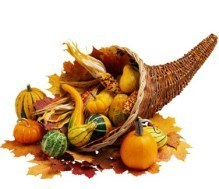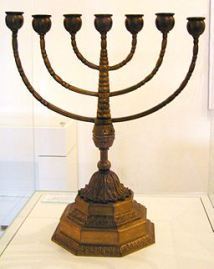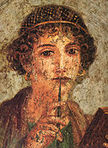Nancy Adams's Blog, page 7
December 5, 2013
Trees, Christmas and Otherwise
Trees have always had a special place in my heart.
My mother loved trees with the unconditional passion she reserved for all things that lie powerless before the adult world: young children, animals (especially cats), Santa Claus, and dandelions. Every fall when the old cottonwood in the corner of our yard loosed its leaves on the next-door-neighbor’s green and pristinely maintained lawn, she would snicker with childish delight. If my father went to prune a tree or shrub in our yard, she argued against it, fearing he’d cut the plant down to the roots and it wouldn’t come up again.
 The books and stories I read reinforced this maternal teaching. Hans Christian Andersen was the first of my favorite authors, and once I stumbled on his works in the school library, I devoured every story, loving them all, no matter how sad or gruesome. Andersen’s “The Little Fir Tree,” like my “Saint Nick,” is told from the tree’s point of view. It strengthened my belief that trees and plants, though mute, have feelings just as humans do.
The books and stories I read reinforced this maternal teaching. Hans Christian Andersen was the first of my favorite authors, and once I stumbled on his works in the school library, I devoured every story, loving them all, no matter how sad or gruesome. Andersen’s “The Little Fir Tree,” like my “Saint Nick,” is told from the tree’s point of view. It strengthened my belief that trees and plants, though mute, have feelings just as humans do.
When I was a child, the most important ritual of Christmas for me was the getting and decorating of the tree. After it was done, I’d turn off the lamps and sit in the dark, taking off my glasses so that the tree lights glowed like big fuzzy balls. In the light of day, I’d stand and contemplate the tree, taking loving measure of every ornament, stroking its spiky branches. Picking out trinkets for our tree to wear is still one of my favorite pre-Christmas activities.
It’s easy for me to understand the tree worship of some ancient cultures. Trees are big, awe-inspiring, and long-lived. There’s more than a whiff of the sacred around them.
But unlike gods, trees are vulnerable.
I was a sophomore in high school when the Tolkien craze hit, and The Lord of the Rings succeeded Hans Christian Andersen in my personal pantheon of mythic tree lore. Tolkien’s Ents, the gigantic “tree shepherds,” are my favorite of all his creations.
Tolkien was no tree-worshipping pagan, but a staunch and in many ways rather conservative Christian Roman Catholic in an England where Catholicism was still somewhat suspect. His reverence for trees is part of the Catholic reverence for the material world as a sacramental witness to the presence of God.
Trees arouse in us powerful feelings because of their size, their beauty, and their longevity: they are a locus for the sacred.
But for all their magnificence and might, trees in Tolkien’s world, as in ours, are tragically vulnerable to the ravages of human self-centeredness and human greed. In The Lord of the Rings, the evil wizard Saruman cuts them down in quantity to fuel the fires that stoke his schemes of domination. Treebeard, the head of the Ents, describes Saruman as incapable of appreciating nature’s beauty: the evil wizard “has a mind made of metal and wheels”.

Treebeard striding through the wood at Tringford Reservoir. The unromantic will claim that this is merely the wreck of an ancient horse chestnut tree and dismiss the outstretched arms, the eyes, the ivy covered nose and the open mouth as pure imagination. This image was taken from the Geograph project collection. The copyright on this image is owned by Chris Reynolds, who presumably also wrote the whimsical description above.
Thus the vengeance of the Ents upon Saruman is a delight. What green tree-hugger hasn’t wished for an army of Ents to add a little muscle to the cause? Unlike Hans Christian Andersen’s story, The Lord of the Rings ends with the trees’ victory.
The Fir Tree of my story does not move in such exalted circles. In many ways “Saint Nick” channels my mother’s antic and rebellious spirit. Fir Tree is cheeky and eager for adventure, in personality more akin to the young hobbit Pippin than to the wise and stately Treebeard. Yet the stories of Tolkien and Andersen run somewhere in its sap, deep down in its treeish DNA.
What’s your favorite tree memory?
This post was originally written for Leila Taylor’s blog, Buried Under Books, where it appeared in Dec. of 2011.
Leave a comment below for a chance of winning “Saint Nick and the Fir Tree” in your choice of paperback or ebook. Contest closes midnight EST Sunday Dec. 8th.
Filed under: Books, Feasts/Seasons, Nature, Trees Tagged: Christmas stories, Christmas trees, Ents, fir trees, Hans Christian Andersen, Lord of the Rings, Saint Nick and the Fir Tree, Tolkien, Treebeard


November 28, 2013
Happy Thanksgiving & Happy Hanukkah
November 19, 2013
Wild Turkeys
A few months back, my husband and I watched an amazing show on PBS depicting how naturalist and writer Joe Hutto raised a brood of wild turkey chicks, imprinting himself as their “mother.”
Rather than hearing my second-hand impressions, here is a preview:
Curious? Click here to view a longer introduction, or here to view the entire documentary.
Here is another link where you can read a fascinating interview with Joe Hutto describing how the documentary came about and how they were able to recreate his remarkable experience.
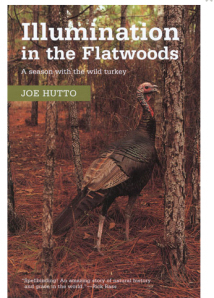 Hutto chronicled his experiences in a book called “Illumination in the Flatwoods.” I haven’t read it yet, but it’s definitely on my TBR list. In the interview above, the interviewer mentions the spiritual impact felt while watching the documentary and Hutto confirmed that the whole experience had indeed had a strong spiritual component. Illumination indeed.
Hutto chronicled his experiences in a book called “Illumination in the Flatwoods.” I haven’t read it yet, but it’s definitely on my TBR list. In the interview above, the interviewer mentions the spiritual impact felt while watching the documentary and Hutto confirmed that the whole experience had indeed had a strong spiritual component. Illumination indeed.
Filed under: Animals, Books, Nature Tagged: Joe Hutto, My Life as a Turkey, Turkeys, Wild Turkeys


November 14, 2013
Madeleine L’Engle’s The Young Unicorns
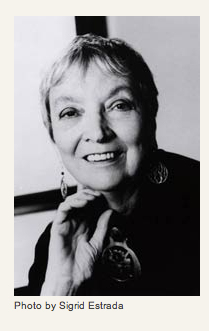
Photo from publisher’s website
Around the same time that I purchased the complete works of Edgar Allan Poe (whose influence is described in a previous post), I stumbled upon Madeleine L’Engle‘s The Young Unicorns while browsing the book department of the same store that had furnished my nice edition of Poe. I believe I was thirteen or so, and the title caught my eye at once, as I loved both fantasy and horses. Plus, I was already familiar with L’Engle’s A Wrinkle in Time, which had been quite literally a life-changing book. The Young Unicorns was to be life changing as well.
The story is set during the period between Halloween and Thanksgiving, and the autumnal mood adds to the overtone of suspense that appears at once on the first page, when we see one of the main characters being followed by three youths in black leather jackets in a dreary November rain. The chiaroscuro contrasts between darkness and light, and the autumnal, occasionally Gothic, sensibility doubtless furnished for me part of the book’s charm. As a writer, I now realize that it’s a great example of a novel of suspense. Perhaps it’s no coincidence that those are the kinds of plots I tend to write.
One of the book’s major characters is a girl named Emily, an extraordinary musician of determined spirit who perseveres in her ambitions to become a concert pianist even after she is blinded by an intruder in her father’s apartment. Her best friend, an older boy named Dave, is a brilliant musician as well, who is also trying to overcome the darkness of his past.
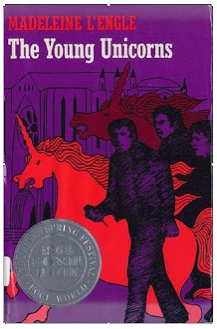 Much of the story centers on the Cathedral of Saint John the Divine in New York City, which is referred to in the book only as “the Cathedral.” Having been raised in a mainstream Protestant denomination, I assumed it was a Roman Catholic church, as those were the only cathedrals I knew of. In actuality, Saint John the Divine is one of the most famous cathedrals of the Episcopal Church, which I joined during college. The works of Madeleine L’Engle, especially The Young Unicorns, were instrumental in leading me to a church where I could feel both spiritually and liturgically at home.
Much of the story centers on the Cathedral of Saint John the Divine in New York City, which is referred to in the book only as “the Cathedral.” Having been raised in a mainstream Protestant denomination, I assumed it was a Roman Catholic church, as those were the only cathedrals I knew of. In actuality, Saint John the Divine is one of the most famous cathedrals of the Episcopal Church, which I joined during college. The works of Madeleine L’Engle, especially The Young Unicorns, were instrumental in leading me to a church where I could feel both spiritually and liturgically at home.
In L’Engle’s book, the Cathedral is a pervasive and numinous presence, at once life-giving, glowing with light, but at other times eerie and unsettling, with rather Gothic overtones. It is the stage upon which both good and evil strut, and is closely entwined with the lives of the main characters. Emily’s friend Dave once sang in the Cathedral choir; her endearingly eccentric teacher, Mr. Theo, is the Cathedral’s retired organist, who still plays for the occasional service. Early in the book, one of the characters describes listening to the Cathedral’s organ with more than one sense by lying down in the choir stalls in order to “feel the music through the wood.” Just as the organ music envelopes such a listener in body as well as mind, so too does the Cathedral completely envelope the plot and characters–and by extension, the reader as well.
Emily and Dave, both lost children, find shelter and stability with the Austin family, who have moved in above Emily’s apartment: parents with two teenage daughters and an small boy who is much like Charles Wallace in A Wrinkle in Time: precocious beyond his years, caring and wise. As the story unfolds, the young people find themselves caught in a web of darkness and evil woven near the heart of the mighty Cathedral itself.
Throughout the story, spiritual issues are touched upon, briefly and lightly but with subtlety and depth, in a way that doesn’t feel preachy or obtrude on the story. That is the kind of fiction I aspire to write.
Filed under: Books, Spirituality Tagged: Madeleine L'Engle, The Young Unicorns


November 7, 2013
Here there be Dragons: Coleridge’s Rime of the Ancient Mariner (another Eco Story)
I’ve always loved dragons and snakes, and been disturbed that Christian iconography typically portrays them as agents of evil, so I was especially delighted to discover a positive portrayal in Coleridge’s Rime of the Ancient Mariner.
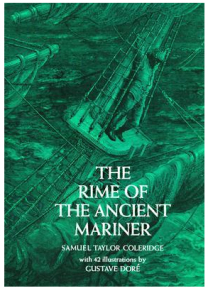 It’s a poem I’m rather ashamed to admit I’ve never read before, and I owe my final acquaintance to one of the delightful Gothic literature groups I recently joined on Goodreads. I was especially struck by the moral of the poem: “He prayeth best, who loveth best / All things both great and small.” Certainly an ecological theme! The basic story of the poem is that the Ancient Mariner of the title comes under Heaven’s curse for wantonly killing a friendly Albatross that had landed on his ship, a bird which the other sailors had taken as a fortunate omen.
It’s a poem I’m rather ashamed to admit I’ve never read before, and I owe my final acquaintance to one of the delightful Gothic literature groups I recently joined on Goodreads. I was especially struck by the moral of the poem: “He prayeth best, who loveth best / All things both great and small.” Certainly an ecological theme! The basic story of the poem is that the Ancient Mariner of the title comes under Heaven’s curse for wantonly killing a friendly Albatross that had landed on his ship, a bird which the other sailors had taken as a fortunate omen.
Even more striking is that the Mariner’s redemption arises from the most unlikely of creatures: a band of water-snakes:
“They moved in tracks of shining white,
And when they reared, the elflish light
Fell off in hoary flakes.
Within the shadow of the ship
I watched their rich attire:
Blue, glossy green, and velvet black,
They coiled and swam; and every track
Was a flash of golden fire.
O happy living things! no tongue
Their beauty might declare.
A spring of love gushed from my heart,
And I blessed them unaware:
Sure my kind Saint took pity on me,
And I blessed them unaware.
The self-same moment I could pray;
And from my neck so free
The Albatross fell off, and sank
Like lead into the sea.”
(Text from The New Oxford Book of English Verse, c1972, p. 534.)

Illustration by Willy Pogany from the 1910 edition, published by Doran. Image from The Victorian Web, scanned by George P. Landow.
I know nothing of Coleridge’s life beyond the bare bones, but I’m curious to know whether he knew anything of Saint Francis of Assisi. Saint Francis, who was officially declared patron saint of ecologists by Pope John Paul II in 1979, is well known for his love of all living creatures. While I’ve never heard any anecdotes that specifically mentioned snakes, there is a story that “he lifted worms from the road for fear they might be trampled underfoot by passersby.” (I was especially gratified to read this, because I often do the same for earthworms when they’ve crawled onto the sidewalks after a hard rain.)
Of course, without further research, there is no way to know whether or not Coleridge was familiar with such stories about Saint Francis. He may merely have soaked up the Romantic movement’s love of nature from his friend and fellow poet William Wordsworth—or he may have loved such creatures from boyhood and needed no model or excuse to sing their praise. Though I have no idea what inspired Coleridge to give his character such unlikely saviors, I’m glad that he did.
Filed under: Books, Dragons & other fantastic beasts, Nature, Spirituality Tagged: eco story, Rime of the Ancient Mariner, Saint Francis, Samuel Taylor Coleridge


October 31, 2013
American Gothic: Edgar Allan Poe
Already primed to love all things spooky by my infatuation with Dark Shadows, it was only natural that a few years later, as I was entering my teens, I became a huge fan of Edgar Allan Poe.
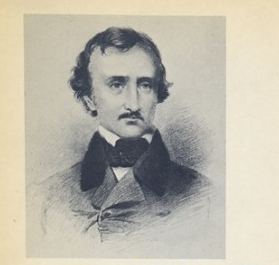 I can’t remember exactly where I found my first book of Poe’s tales, but it was a children’s edition called something like “12 Tales of Horror” and contained the best-known stories: “The Murders in the Rue Morgue,” “The Purloined Letter,” “The Pit and the Pendulum,” “The Tell-tale Heart,” “The Black Cat,” etc. I eagerly dived in, and was absolutely captivated by the sheer artistry of the language—something that still captivates me every time I read anything by Poe.
I can’t remember exactly where I found my first book of Poe’s tales, but it was a children’s edition called something like “12 Tales of Horror” and contained the best-known stories: “The Murders in the Rue Morgue,” “The Purloined Letter,” “The Pit and the Pendulum,” “The Tell-tale Heart,” “The Black Cat,” etc. I eagerly dived in, and was absolutely captivated by the sheer artistry of the language—something that still captivates me every time I read anything by Poe.
I don’t believe that collection had any poetry, but I had a couple of small, well-thumbed children’s anthologies, and I’m pretty sure that “Annabelle Lee” was in one of them. And then I seem to remember having an edition of “The Raven,” one of those tiny little pocket-sized hardbacks with some black-and-white illustrations. “The Raven” was (and still is) absolutely mesmerizing, and opened up a whole new sensibility for me. It has to be one of the most perfect poems in the English language, marrying aural sense to sensibility in a way that was unmatched in my reading experience.
I do remember when, sometime during my early teens, I bought the complete book of Poe’s works that I still own. This was an era when department stores often had sizeable book departments, and I can still remember seeing the book’s substantial spine on the shelf when I went to browse while my mother shopped for clothes. Even now, after decades, its sturdy spine still opens like new. The dust jacket, alas, has not fared so well, but its pen-and-ink illustration of a long-haired woman beneath a leafless tree is still strikingly atmospheric, the tree topped by a bird—doubtless Poe’s Raven—with an Usher-like mansion and more leafless trees in the distance, the object of the woman’s gaze. On the jacket’s back, Poe’s eyes evade the onlooker, staring into the distance, lost in his imagination perhaps, or perhaps merely directing his gaze according to the wishes of the portraitist. The creamy, deckle-edged pages remain like new, unfaded and unblemished despite many readings.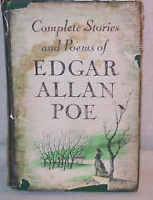
It was Poe who ignited my fascination with foreign languages. Many of his stories begin with an epigraph in French, Italian, or Latin, and I longed to learn those tongues to know what these mysterious words meant. At the same time, not knowing added to the stories’ air of mystery and mystique. I imagine it was this desire to unlock the mysteries of Poe’s epigraphs that was responsible for my choice of French over Spanish—a decision that was to have many consequences for my intellectual and interior life—as well my eagerness to master the new language’s intricacies, to unlock its secrets. In addition, with the advantage of hindsght, I would also venture to say that Poe’s stories were my first steps out of childhood, my first ventures in reading that were not penned with children in mind.
In graduate school, I learned that this sort of art, that which mingles an element of terror or disproportion or unease, is called “the sublime,” as opposed to the classically “beautiful.” Emmanuel Kant wrote a treatise on the subject, and I assume the theory was developed in the late 18th century due to the rise of Gothic tales such as those penned by Anne Radcliffe and others. It certainly applies to the works of Poe.
Every year around Halloween, I get out my old, reliable edition of Poe, and each time, he never disappoints, never fails to move me with the beauty of his language and the psychological penetration of his art. Like the woman in Shakespeare’s sonnet, whom “age cannot wither nor custom stale,” after the passing of decades and many readings, Poe’s work continues to evoke in me a strong emotional response: rapt to the beauty—and terror—of his words.
Filed under: Books, Feasts/Seasons Tagged: Edgar Allan Poe, Gothic, Halloween


October 24, 2013
Roman Gothic: The Secrets of the Sibyl
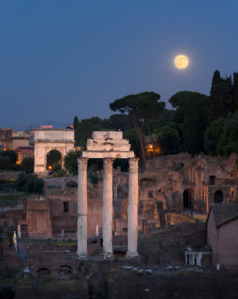 This is the time of year when my reading takes a supernatural turn. The approach of Halloween initiates the mood, and chill autumn evenings invite the pleasures of sitting snug and cozy while vicariously experiencing creepy thrills. During this season, I often find myself turning to old favorites like Edgar Allan Poe or modern masters of the supernatural like Phil Rickman’s Merrily Watkins series.
This is the time of year when my reading takes a supernatural turn. The approach of Halloween initiates the mood, and chill autumn evenings invite the pleasures of sitting snug and cozy while vicariously experiencing creepy thrills. During this season, I often find myself turning to old favorites like Edgar Allan Poe or modern masters of the supernatural like Phil Rickman’s Merrily Watkins series.
It’s true for me as a writer, too. I’ve just written a short story called “The Black Cat” that’s a bit of a riff on the tale by Poe. Another short story I composed this time of year, “The Secrets of the Sibyl,” is a conscious effort to import motifs from Gothic literature into the historical setting of my Roman novels, a sort of “Roman Gothic,” if you will.
“The Secrets of the Sibyl” takes place in the 4th-century world of the Late Roman Empire and is set in the ancient town of Cumae. For 4th-century Romans, Cumae had great historical significance. According to Virgil’s Aeneid, their great national epic, Cumae is where the wandering Aeneas, fugitive from the defeated city of Troy, first set foot on Italian soil. Cumae, an ancient Greek city renowned as home to the Sibyline oracle, is already known to Virgil’s hero, and his first thought is to seek counsel from the prophetess: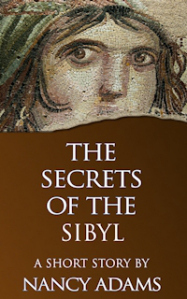
“But Aeneas, that righteous man,
The dread Sibyl’s secret sanctuary sought:
A cavern, enormous,
Hewn from the native rock.
A hundred pathways lead there,
A hundred mouths give utt’rance,
Proclaiming with a hundred voices,
The Sibyl’s hidden knowledge.”
–Book 6 of the Aeneid
(my translation)
For the 4th-century Romans of my story, Virgil was not only the author who had given voice to the legendary beginnings of their nation, but a literary genius whose influence on them and subsequent Italian generations was comparable to that of Shakespeare in the English-speaking world. Once I’d mastered enough Latin to read the Aeneid in Virgil’s original language, I was equally smitten.
With the quote above as inspiration, I eventually conceived a story that would give my young series heroine an ancient, crumbling villa to explore, a villa located in Cumae. Since the town is on the Bay of Naples, where wealthy Romans typically owned summer homes, it wasn’t too difficult to create the scenario. Add an old servant in possession of a horrible secret, a visit to the site of the Sibyl herself, a nighttime prowl through the decrepit villa—and voila, Roman Gothic. I had great fun composing it.
Does October bring out the Gothic in you? What sorts of things do you most enjoy reading and writing this time of year?
Filed under: Books, Feasts/Seasons Tagged: Gothic, Halloween, historical fiction, historical fiction set in ancient Rome, Nancy Adams, October, reading, Roman, The Secrets of the Sibyl


October 17, 2013
American Gothic: Dark Shadows
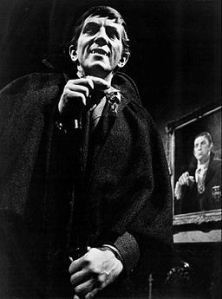
Actor Jonathan Frid as Dark Shadows’ vampire Barnabas Collins, photo courtesy of Wikimedia Commons
My fascination with all things creepy began early in life. While I was still in elementary school, fourth or fifth grade, I’d rush home each day to watch the next installment of Dark Shadows. I’m sure I’m not the only fan of Charlaine Harris and other vampire-themed novels who was first bitten by the bug, so to speak, watching Victoria Winters and Barnabas Collins.
Last spring my husband found DVDs of the show when he was browsing through a catalog of books and videos. Remembering how I had talked about loving the series, he was thoughtful enough to point it out to me. Now, he probably wishes he hadn’t. We promptly ordered the first episodes, and I was astonished to discover that Barnabus, the vampire, doesn’t appear until six months into the series. It was a wonderful treat to sit down and watch THE VERY FIRST episode of Dark Shadows! Of course, like potato chips, one was never enough, and I found myself begging to watch a couple of them every evening, although my husband soon wanted a change in the menu.
I’m delighted to report that the series is every bit as good as I remember. In fact, even better. As an aspiring writer of the mysterious, I’ve spent some time over the last few years studying the mechanics of plotting and suspense, and Dark Shadows offers a good deal of instruction for anyone interested in crafting their own kind of creepy.
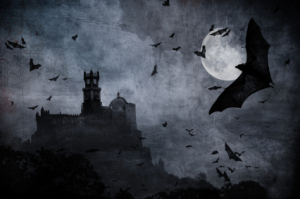
Gothic landscape (purchase from istock)
What was it that drew me and so many others to the series? The atmospheric black-and-white shot of the breaking tide that cuts to the huge, gloomy pile of Collinswood Manor looming on the cliffs above, accompanied by actress Alexandra Moltke ‘s perfectly pitched voiceover: “My name is Victoria Winters…” that opens each show sounds all the Gothic themes that appeal to something deep and primal within our collective psyche. As do the mysteries surrounding the Collins family for whom Victoria has come to work. As do vampires and secrets.
Not everyone’s cup of tea. But for those of us who can’t get enough of things that go bump in the night, who enjoy a vicarious frisson, this series made the perfect introduction to the pleasures that can be found in exploring the darkness and shadows that lurk within the human condition.
How do you account for this fascination with the dark, the world of shadows, the supernatural, the unknown? And what are your favorite spooky treats (books, TV, or movies)?
Filed under: Feasts/Seasons Tagged: Dark Shadows, Gothic, Halloween, spooky, vampires


October 10, 2013
Squirrels vs Pumpkins
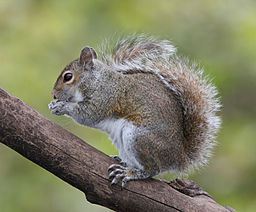
Eastern Grey Squirrel, photo by BirdPhotos.com, courtesy of Wikimedia Commons
Squirrels are the Coyote of the East. In American Indian folklore, Coyote is the ultimate Trickster, a role that squirrels fulfill quite well.
For all their tricksy ways, I still like the little guys. I love watching them leap across the grass or road, graceful arcs of brown-gray fur, scrambling up a tree to swing in the branches and chatter down at anyone below, North America’s own little monkey. Chasing one another round and round a thickly trunked tree, tails fluttering; racing over telephone wires, branches, and gutters to traverse a block or more without ever touching the ground, a high-wire act free for the watching.
But Squirrel the Trickster likes to eat flower bulbs, chew his way into your attic, and—the worst offense of all—devour our decorative pumpkins.
I love celebrating the seasons, and once we had our own single house, with a big, lovely porch instead of a stoop, I couldn’t wait to decorate. The moment fall arrived, I hurried to the farmers’ market, where I procured pumpkins and colorful corn, eager to welcome the season.
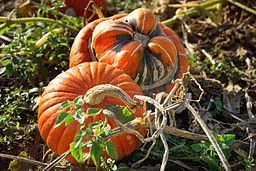
Photo by Nicole Gordine, courtesy of Wikimedia Commons
But, alas, in a scant few days, the corn was devoured, nothing left of the colorful bundles but mere cobs and stalks. The pumpkins had teeth marks, and with each passing day, the poor things suffered more and more, until at last they bore huge, gaping wounds—a gory sight truly worthy of Halloween.
Yet all our neighbors still had pumpkins, whole and plump, unblemished by any rodentary predation. What were we doing wrong? Could the squirrels sense my liberal, animal-loving, bleeding heart? Did they know they could make war on our pumpkins and fear no reprisals?
Years have passed since that first fall in our house, and now I’ve finally given up on the corn and the pumpkins, not without a twinge of regret. But maybe next year I’ll try again. I know there are ecologically sound rodent repellents (or would they repel us, too? To say nothing of the neighbors, the mailman, friends we might have over….) Still, something to think about.
Meanwhile the squirrels continue to chatter from above.
Laughing at us, I’m sure.
Filed under: Animals, Feasts/Seasons, Nature Tagged: autumn, fall, pumpkins, squirrels


October 3, 2013
Interview with author Yves Fey
Today I am pleased to present an interview with one of my favorite writers, Yves Fey, author of Floats the Dark Shadow, an atmospheric historical mystery that absolutely knocked my socks off. Before proceeding to the interview proper, here’s a little introduction to the author and her work:
 FLOATS THE DARK SHADOW is Yves Fey’s first historical mystery, set in the dynamic and decadent world of Belle Époque Paris. Yves Fey has an MFA in Creative Writing from Eugene Oregon, and a BA in Pictorial Arts from UCLA. She has read, written, and created art from childhood. A chocolate connoisseur, she’s won prizes for her desserts. Her current fascination is creating perfumes. She’s traveled to many countries in Europe and lived for two years in Indonesia. She currently lives in the San Francisco area with her husband and three cats. Writing as Gayle Feyrer and Taylor Chase, she previously published unusually dark and mysterious historical romances.
FLOATS THE DARK SHADOW is Yves Fey’s first historical mystery, set in the dynamic and decadent world of Belle Époque Paris. Yves Fey has an MFA in Creative Writing from Eugene Oregon, and a BA in Pictorial Arts from UCLA. She has read, written, and created art from childhood. A chocolate connoisseur, she’s won prizes for her desserts. Her current fascination is creating perfumes. She’s traveled to many countries in Europe and lived for two years in Indonesia. She currently lives in the San Francisco area with her husband and three cats. Writing as Gayle Feyrer and Taylor Chase, she previously published unusually dark and mysterious historical romances.
SAT: Welcome to the blog! When did you first become interested in Paris? I don’t mean writing about Paris, particularly, but what drew you to Paris as a place you might like to read about or visit?
YF: I’ve been a movie addict since kidhood. My love affair with Paris began with An American In Paris, which I saw when premiered. What’s very hokey about it now wouldn’t have bothered me then, and even now the Art inspired ballet at the end is amazing, with Lautrec, Renoir, and Dufy etc. Apparently it was filmed in the studio, but in my mind I’ve added the real Paris backdrops when I think of it. And then the Belle Époque romance of Gigi…
SAT: Given that, what led you to set a story in Paris?
YF: I used to write historical romance, but switched to mystery because my sensibility was too dark. Although Paris is my favorite city, I was also enamored of the beauty of Venice and wanted to set my first romance there. I couldn’t find a historical event that pulled me, so I set it in Florence during the conflict between the Borgias and Savonarola. Next book, I planned to do something à l à Colette, set in Paris. I was told that Paris wasn’t romantic to romance readers. Couldn’t I do Scotland?
Paris continued to claw at my brain to have a novel. When I decided to do an historical mystery, it was at the top of the list for setting, with not much in second place. But finding the right story for the setting took some time.
SAT: What do you like about writing historical fiction?
YF: I’m not all that fond of the present, though I do worship at the altar of my big screen TV. I like reading and writing about history so I can live there vicariously.
SAT: Why fin-de-siècle Paris in particular, the post-Baudelairean Paris of the Symbolist poets and décadents, rather than some other period of French history?
YF: Before I knew who my villain was, I considered a wider time frame, though the 80s and 90s had the edge. I wanted an American artist heroine who was a student of Impressionism or one of the other movements of that era. While there were many artists working in early post-1900 Paris that I love, I do prefer the works of the latter half of the 19th century to the modernists, so that was a big factor. But edging it toward the 20th century also offered a lot of interesting artistic turmoil for the heroine to encounter throughout the series. I didn’t want the shadow of the Civil War hanging over my heroine, so that excluded the 1860s. I was interested in referencing the Commune, but I didn’t want the bleakness of 1870s Paris. I also hoped to have Oscar Wilde as a character at some point (I’d planned a scene where he met the Revenants in Floats the Dark Shadow, but there wasn’t room for it, so he’s just referenced and is an alibi for one crime). I also had hopes of doing Hugo’s funeral in flashback, but that didn’t work out. Those things were all part of the decision, as I looked at who was alive and working in Paris from 1860-1900, and what events I might include.
Somewhere in here, when my first plot wasn’t coming to life, I decided on a Gilles de Rais copycat for my villain. Huysmans book about Gilles de Rais, La Bàs, was published in 1891, so I focused my research on the 90s. In my reading, I found the story of the Bazar de la Charité, and decided it was a wonderful dramatic scene. I love having a big historic event in my books, even if it’s not one that’s well remembered now, so that was the deciding factor for the year 1897. I’d even thought Michel and Theo might meet at the Bazar, but that chapter kept moving toward the center and I wanted them to have some contact about the murders before that. Somewhat later, I found the story of the midnight concert in the catacombs, and was overjoyed that it happened earlier that year. Those were my historic lynch pins. I hadn’t paid a huge amount of attention to the dates of the Commune at first, as it was going to be dealt with in Michel’s memory, but then I saw that it framed the events of the novel as well. As for the poets, the greatest of the era were all mostly dead—Baudelaire, Rimbaud, Verlaine—but they were still the main influences on the Revenants.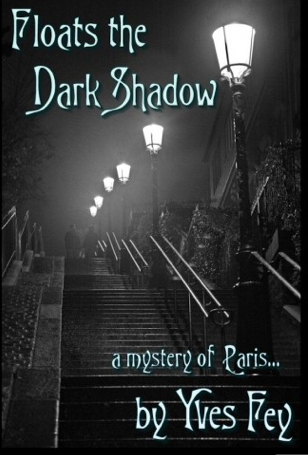
SAT: Where did Theo come from? Do you have any background as an artist yourself?
YF: I do have a degree in art, and when I decided to write a mystery set in Paris, I absolutely wanted an artist heroine because I felt I could bring her to life vividly, and have her see Paris in a unique way. Theo and I share a lot of opinions—but not all, and she’s much braver and more direct and emotional than I am.
I had a completely different character at first, but she refused to be an artist, she wanted to be a journalist. I struggled for months with that character and plot, and had all but given up when my copycat killer idea came up and flipped everything around. Theo and Michel had actually been characters in an abandoned historical romance, an Elizabethan La Femme Nikita. When the cop took on new importance to track down my copycat killer, I seized upon them, but had to really reimagine their backstories, since the spy framework put totally different pressures on them that vanished with the fin de siècle Paris setting.
SAT: Tell us how you went about researching the details of 19th-century police work in Paris that are so essential to your portrayal of Michel and to the plot of your story?
YF: That was and is one of the hardest aspects, as my French is nowhere near good enough to use original sources. I hunted the whole time I was working for more and better information in English. I had a book called Crime Scene Stories that was very useful. And I had a great find in a book of the period, with lots of etchings, called The Paris Law Courts, which had great information on how prisoners were booked and what the interior of the jails was like.
I’ve made Michel a member of the Special Brigade, which was quite real, and let him play a bit fast and loose with the hideously bureaucratic French police and law system. There is lots of information available on Bertillon’s complex system of anthropometry which was in use all over the world at the time, before being supplanted by fingerprints. So I could play around with that. There were a lot of big changes happening, so information on historic cases and changes in practices are relatively easy to find, but basics are elusive.
I have visited parts of the old prison, and the Police Museum in Paris.
SAT: I love your website, and it’s even more remarkable to me that you did it all yourself. Tell us how you went about the process of learning the techniques and designing the site.
YF: It was achieved with much floundering and flailing. I did read up on WordPress, but not nearly enough to be confident. The language was too confusing, even though I’d done a little programming in MOO, I’d mostly forgotten it—I was never good at it. I felt overwhelmed, so I decided to do one thing at a time. But one thing would lead to another, and another…arrgh.
I tried a couple of different themes with pretty colors, but they were too limited. Then I found Weaver, which promised to let me do pretty much whatever I wanted in terms of color (very important for an artist) and layout. And, I was able to do just about everything that I did want to do, but I would often look for the explanation in the wrong place and spends days or even weeks getting the wrong advice for things that turned out to be relatively simple if you knew where to look. The biggest of these happened pretty early on. I knew I wanted to have different images at the top of different pages. This is easy to do with what they call the Featured Image. But I misunderstood and thought that the Featured Image was a picture included in the text of the blog or page. So I asked around on the forums and got the wrong advice, or too difficult advice, or advice that worked but limited something else. Weeks later, someone asked, Why don’t you just use the Featured Image? So I got my different banners to introduce my different topics. There were several other things that drove me insane because they required so much hunting to figure out, or find the right widget to make work. It’s very crazy-making when you think something will take 2 hours and it takes 2 weeks!
Some of the things were easy from the start, like doing my own backdrop and picking font colors, but still took a long time just because I fiddle endlessly. Just recently I changed my background because so many people have trouble reading light text on black. I love black and find it easy to read light on dark. It suited the dark feel of the book, but I caved since it was really a big issue where some people could not read the text. But I sort of sigh when I land on glaring white pages. I find them really boring. The new background is a teal and I do like it, even if it’s not as Gothic in feel as the black. It’s a huge site, but I did ask friends who had old cranky computers if it would load, and it would, so I’ve gone with what I wanted. It will probably be in progress forever, as far as adding text goes, but all the pages have wonderful art to look at. I’ve done most of it myself, but I did get some help with some of the lettering and with frames on the art. The fun part was hunting the art, though that took ages as well. I knew many of the artists, of course, but I kept finding more and more wonderful relevant art I wanted to include.
SAT: Your current passion is creating perfumes. A most unusual hobby! Tell us how that came about.
YF: My best friend and I had done some perfume quests in the past, and we had a couple of favorite perfumers, Serge Lutens and Les Parfums de Rosine, who were based in Paris. On a research trip, I’d already spent my allotted perfume money on Arabie and Rose d’Éte. It was pretty much time to leave when I happened on a shop in the Marais where you could design your own perfume. I thought that would be great fun, but I’d bought my perfume and was running around trying to finish my research, so I didn’t go in. It wasn’t until after I left that I got the idea to design a perfume for one of the characters. Back home, I began to play around a little without much success. On my next trip, I did design a perfume for my courtesan, Lilias. It came out really well. I thought I could use some to promo the book—but the book took longer to write than expected, and I used up the perfume myself. I began doing more experiments at home, and being an obsessive personality, was soon pretty much lost in my creations. It’s really difficult! I’ve ruined more things than I’ve succeeded at, but I do love it. Theo has been totally elusive. I’ve got a fun spicy rose for Carmine, a dreamy absinthe inspired scent, and a yummy Paris Patisserie.
SAT: Thank you so much, Yves! I’m sure I’m not the only one who eagerly awaits the next installment of Theo’s adventures.
Floats the Dark Shadow has already been listed for a number of awards. For more information, and/or to order a copy, visit the author’s website at: http://yvesfey.com
Filed under: Books, Guest blogs, Interviews Tagged: Floats the Dark Shadow, historical fiction, historical mysteries, Paris, Yves Fey



